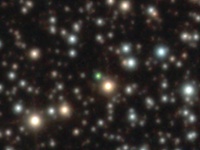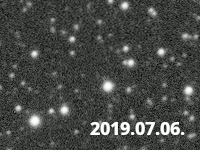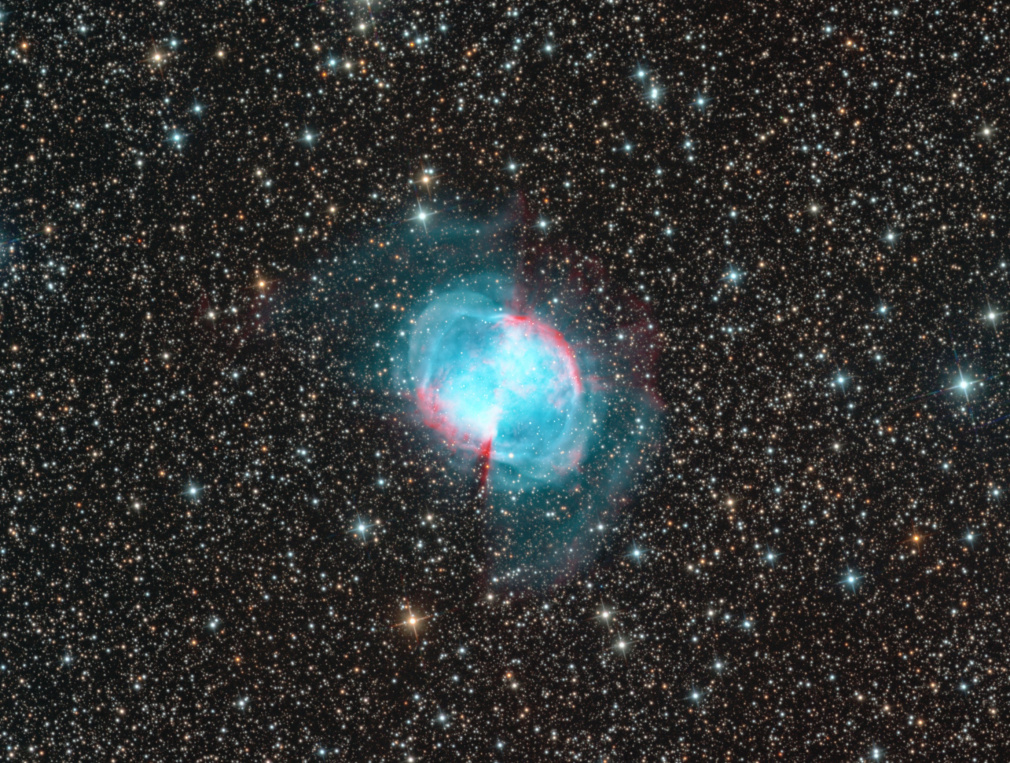Two interesting objects: a green (not really) star, and the first planetary nebula ever discovered by humanity.
The Dumbbell Nebula was discovered in 1764 by the French astronomer Charles Messier. It was the first planetary nebula known to humanity, but, of course, Messier could not know about the nature of the object, he described it as an oval shaped nebula without stars in it. The credit for the name goes to John Herschel, who compared the shape of the nebula to a dumb-bell, almost 64 years after the discovery.
Planetary nebulae have nothing to do with planets, the name is misleading. Most of them resemble planets observed visually using a telescope, hence the name. They are formed by giant stars near to the end of their lives. The outer layers of these stars are ejected into the interstellar space exposing their hot cores. The cores are so hot that they radiate in ultra-violet wavelengths, which radiation then ionizes the expanding clouds of gas, making them glow in different colours based on their material. This is exactly how Messier 27 was form. The small blue star at the centre of the nebula in the image is the exposed core of the progenitor star, it appears blue, because it is hot, its surface temperature is about 85000 Kelvin (the surface temperature of our Sun is only 5700 Kelvin). The nebula around it is the rest of the star expanding into space. Two colours dominate the image of the nebula: turquoise and red. Turquoise is the colour of ionized oxygen, and red is ionized hydrogen. These two colors show how these materials are distributed around the star.
Messier 27 is about 1200 light-years from us, and its actual size is approximately 1.4 light-years. Expanding material of planetary nebulae dissolve into space fairly quickly (in astronomical terms), so the ones that are visible must be young (again, in astronomical terms) objects. There were multiple studies aimed to determine the age of the Dumbbell Nebula by measuring the size and expansion rate of different parts of its structure, the results were between 3000 and 14000 years.
 Besides the glorious nebula, there is another interesting object in the picture: a green star. It needs to be explained, because there are no truly green stars in the Universe. The star is a variable star, called SW Vulpeculae. Variable stars change their brightness over time. There are several types of variable stars with different behaviour caused by different physical phenomena. SW Vul is a cataclysmic variable star. These stars are close binary systems consisting of two stars: a white dwarf and a secondary star orbiting each other. They are extremely close to one and other, so close that gravity of the white dwarf can distort the secondary star and matter is transferred from the secondary onto the white dwarf. When pressure and temperature at the bottom of the accumulated hydrogen layer reaches a certain limit, it triggers hydrogen fusion that emits a lot of energy. The total brightness of the system increases suddenly and remains higher while the reaction is going on. Then the cycle starts again after all the accumulated hydrogen is converted to helium. This kind of stars are also called novae, or guest-stars, because an otherwise too dim system can become visible to the naked eye during the outburst. From an observer-point of view a 'new star appears' in the sky.
Besides the glorious nebula, there is another interesting object in the picture: a green star. It needs to be explained, because there are no truly green stars in the Universe. The star is a variable star, called SW Vulpeculae. Variable stars change their brightness over time. There are several types of variable stars with different behaviour caused by different physical phenomena. SW Vul is a cataclysmic variable star. These stars are close binary systems consisting of two stars: a white dwarf and a secondary star orbiting each other. They are extremely close to one and other, so close that gravity of the white dwarf can distort the secondary star and matter is transferred from the secondary onto the white dwarf. When pressure and temperature at the bottom of the accumulated hydrogen layer reaches a certain limit, it triggers hydrogen fusion that emits a lot of energy. The total brightness of the system increases suddenly and remains higher while the reaction is going on. Then the cycle starts again after all the accumulated hydrogen is converted to helium. This kind of stars are also called novae, or guest-stars, because an otherwise too dim system can become visible to the naked eye during the outburst. From an observer-point of view a 'new star appears' in the sky.
 So how, this star became green then? Long series of images were taken for this picture using a monochrome camera and red, green and blue filters to produce a colour photograph. SW Vul was in outburst when green images were taken, and was mostly dim while red and blue filter was used. Since the star was dim while most of the red and blue images were recorded, the star appears green in the final image. On the right, two raw images taken on different days with the red filter can be seen: in July, the star was dim, on 1st of August it was in outburst. The bright star in the image next to SW Vul is not its companion, it is an unrelated star. The resolution of the imaging equipment used to capture this image is not high enough to resolve the white dwarf and the secondary star.
So how, this star became green then? Long series of images were taken for this picture using a monochrome camera and red, green and blue filters to produce a colour photograph. SW Vul was in outburst when green images were taken, and was mostly dim while red and blue filter was used. Since the star was dim while most of the red and blue images were recorded, the star appears green in the final image. On the right, two raw images taken on different days with the red filter can be seen: in July, the star was dim, on 1st of August it was in outburst. The bright star in the image next to SW Vul is not its companion, it is an unrelated star. The resolution of the imaging equipment used to capture this image is not high enough to resolve the white dwarf and the secondary star.
